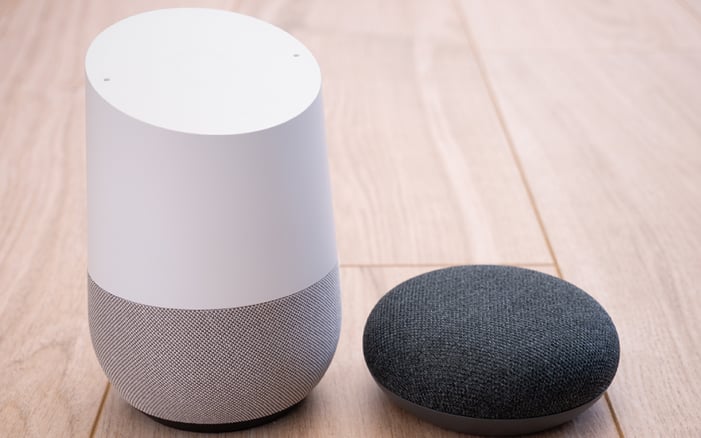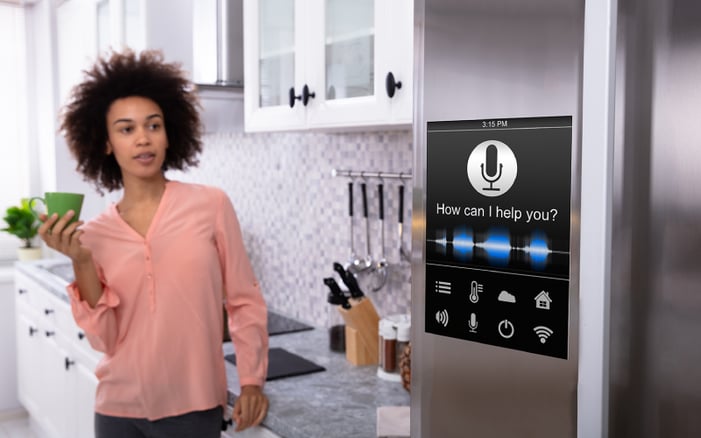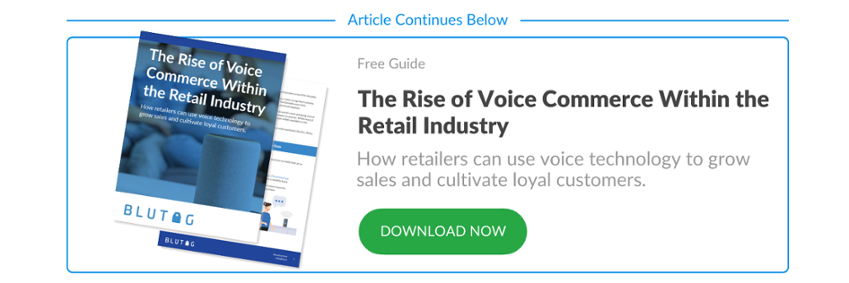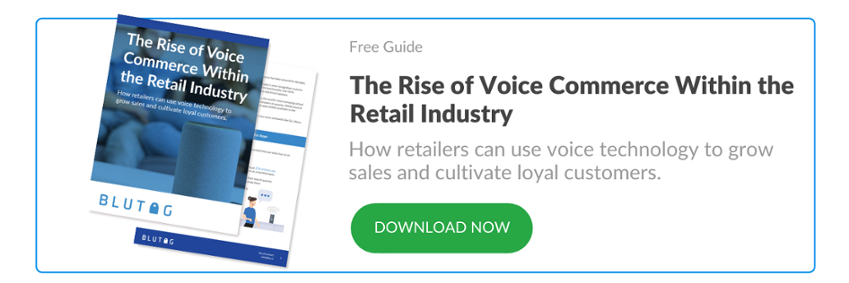Believe it or not, the development of voice-assisted search and artificial intelligence has been around for decades.
The IBM Shoebox from the early 1960s is widely known as the forerunner for today's voice recognition systems. It was a voice-activated calculator that could perform simple arithmetic. While its functionality was fairly rudimentary, the real innovation laid in the device's ability to convert sounds into electrical impulses.
Fast forward to the 1990s, and some of you might remember Microsoft's Clippy, the world's most annoying virtual desktop assistant who could recognize speech and search for potentially useful answers to queries. While most of us simply ignored it, Clippy was one of the earliest iterations of voice recognition apps widely available to the average user.
These early versions of voice assistants have laid the foundation for the modern-era voice assistants like Siri, Alexa, and Google Assistant.
Growth and Trends of Retail Voice Apps
Voice apps are being rapidly implemented on smart devices globally and incorporated into our daily lives at an incredible rate. It's a trend that isn't slowing down.
Some incredible rates to note:
- 55% of US homes have some form of smart home technology, and at least 27% of them use voice assistants or voice interfaces to interact with their smart devices on a monthly basis.
- 43% of smart speaker owners use the technology to shop.
- 71% of consumers prefer to use voice searches instead of typing out their search queries.
- 51% of all US online shoppers report that they use voice assistants to help them research products.
- Lower ticket items and entertainment are the top categories currently benefiting from voice shopping, with 21%+ using voice for apparel, 25%+ for everyday household goods, and 21%+ for entertainment
These rates represent an upward trend in the general adoption of voice apps and smart home technology, reflecting the way consumers are searching and making purchases. It's no wonder that voice shopping is estimated to become a $40 billion channel in the US by 2022.

Examples of Top Retail Voice Apps
The tremendous growth of consumer activity demonstrated above has drawn the attention of top retailers eager to tap into voice ordering by making their product lines available through voice search apps like Alexa or Google Assistant.
Here are a few examples of top retailers who are tapping into voice-activated shopping.
1. Rothy's
Popular women's footwear and accessory company Rothy's offers flats, pointy shoes, and more through their voice app.
2. Bloomingdale's
Bloomingdale's customers can ask for store locations, check on open hours, request coupons and deals, and of course, search and order products through the Bloomingdale's voice app.
3. Black Rifle Coffee
Veteran-owned coffee roast-to-order company Black Rifle Coffee offers coffee ordering, reordering, and status checks through their Alexa Skills enabled app.
4. Walmart
Walmart has been actively expanding its product line availability through Siri and Google Assistant.
5. Dominos Pizza
Order a pizza and get it delivered and ask your assistant where it is along the way.
Why You Need A Voice Shopping Strategy
There are millions of products and thousands of brands available through voice shopping apps, and the availability of products and services continues to grow every year. Voice shopping streamlines the online shopping experience and resonates well with younger consumers who have always known digital experiences. And as older consumers are increasingly becoming more sophisticated with online shopping (with some recent thanks to pandemic lockdowns), their pickup of voice shopping will trend up as well.
"If you're a retailer and you're not preparing for this significant trend of e-commerce going toward v-commerce, then you won't be around."
- Greg Melich, Senior Retail Analyst, MoffettNathanson
Beyond the fact that voice shopping is growing annually, there are many other critically important reasons why every retailer needs a voice shopping strategy in 2021.

1. Early Mover Advantage
There is always an advantage in providing better access to your products for consumers in any competitive market.
With a very evident rise in consumer adoption of voice technology and an increase in purchasing trends through voice shopping, there is a swell of brands and companies eager to ensure that their product lines are available to those users.
Brands that continue to delay their investment into voice will have a more difficult time ‘cutting through the noise’ as the competition in their verticals increases.
Early movers have an advantage that can put them ahead of the competition in terms of discoverability through voice search. The ease of voice ordering also enhances the user experience and encourages replenishment purchasing.
2. Increase In Sales Per Order
Suggesting additional items based on what customers are ordering has proven to work very well with online shopping, so it is a given you would not want to lose tapping into this method of securing more sales. To do this, you'll need to ensure your voice app can make suggestions based on what your customers are putting in their carts.
Although it is still early days to present data on how effective the method is with voice shopping, it is interesting to note that voice shopping paves yet another way for people to multitask. You can argue it is the most potent enabler of multitasking yet! Now users can shop while driving, cooking dinner, working out, etc. Multitasking shoppers are not entirely focused on the task at hand and can be more susceptible to suggestions, leading to more items placed in their carts!
3. Higher Lifetime Value
While most purchases through voice are for $100 or less, customers' lifetime value tends to increase once they have established trust with a company and have discovered the convenience of ordering through voice for daily shopping.
The convenience of voice shopping, particularly for everyday purchases, such as dish soap or paper towels, leads to an increased lifetime value from customers who actively use voice shopping and have established trust with a brand or company.
This type of consumer activity is a strong approach to increasing a customer's lifetime value, which is a very compelling case for any business considering if they need a voice shopping strategy in 2021.
Early adopters and brands that can establish trust and loyalty with their customers through voice have a significant advantage over the competition. They will build an opportunity that increases the average sales per order and drives up their customers' average lifetime value.
So What Can Voice Shopping Do For Retail?
Voice shopping is a versatile user experience that can add many elements to the customer experience and influence how they interact with your brand through their smart devices.
Discoverability
Discoverability is a critical (and very competitive) element of voice search and shopping.
Users can engage with their smart devices by verbally presenting a query such as "department stores near me" and be presented with voice search results that match the query. By 2020, 50% of all searches will be voice-activated, representing a massive opportunity for retailers to increase their discoverability by new and existing customers.
Top voice searches for products include grocery (20%), entertainment (19%) and electronics (17%) and Clothing (8%.) But making sure your skills are up to speed and that you’ve referenced your product in the most searchable way is important. According to Chain Store Age, 69% of customers know the exact product they wish to buy. So you need to write your skills to be both generic to be found, but distinctive for people who are looking for specific products.
Voice search optimization is a competitive space and presents many opportunities as brands try to modify their search engine optimization strategies to include or target voice searches.
Automatic Reordering
Customers are continually looking for convenience, particularly on repeat "chores," such as ordering coffee, dog food, and detergent. Offering voice shopping as a handy tool for your customers to reorder products quickly is smart business. Automatic reordering takes this a step further by allowing retailers to tap into customer order histories to automatically find products they refer to when they casually indicate something like "order more/reorder coffee".

Automatic reordering can also be set up to suggest that a customer orders more of something based on set time intervals, certain activity triggers, or via smart device monitoring.
Automatic reordering makes shopping seamless for customers, boosts average customer revenue, and encourages repeat purchasing activity.
Delivery Notifications
Voice apps are also beneficial for improving the customer experience after they have made a purchase. Delivery mishaps or delays can be a significant point of frustration for consumers. Voice apps can help prevent customer dissatisfaction by providing updates on deliveries and timely notifications throughout the process. Notifications reaffirm trust with your brand and ensure that the customer experience is positive throughout.
How this feature functions is that delivery notification and order status updates are sent directly to customer devices. A user's smart speaker then triggers a light or vibration when a new notification comes through that the user can interact with at will.
Replenishment Reminders
Consumers can overlook annual or monthly purchases. Here is where a little prompting can go a long way.
Voice apps can send out reminders based on certain activity triggers or specific time intervals to notify consumers when it's time to replenish a product. Reminders help boost the lifetime value of customers and encourages repeat purchases.
Status Updates
Customers like to know the status of their purchases. Particularly in a channel where security and privacy can be an initial concern for consumers, status updates are one method for voice apps to help reaffirm customer confidence. Plus, it’s fun to find out where your package or pizza is!
Voice apps can provide ongoing status updates on a purchase, such as confirming receipt of payment, shipping status, 'back in stock' updates, and many other touchpoints throughout the purchasing journey that increase consumer confidence and activity with their brand.
Promotions
Voice apps can help facilitate promotions by making announcements and letting users know about active or upcoming discounts or deals for products they might be interested in.
Promotions effectively increase conversions and order volume, particularly when used in a targeted campaign towards certain user segments or triggered by specific user activity.
Daily deals, coupon offerings, flash sales, and other promotions are easy to roll out through voice apps and ensure that you present them to potential customers at the exact right time in their buyer's journey.

How To Get Started With Voice Apps For Retail Businesses
Sometimes voice apps can seem like magic…
However, in reality, there's a ton of artificial intelligence, software development, and cross-platform integration in the background to make it a seamless experience for users.
Despite the technology and innovation driving this channel, it's not as complicated to implement for your brand as one might expect. There are actually many ways to get started with voice apps, but they each have their own set of benefits and challenges.
1. Build Your Own Voice App
Building your own app might be one of the most challenging and expensive approaches to setting up a voice app for your retail business.
It requires specific developer expertise and a strong understanding of how the app can integrate within the current ecosystem of the most commonly-used voice systems such as Google Assistant or Amazon Alexa.
Pros for Building Your Own Voice App:
- Total ownership of the final product
- Flexibility of design
- Control of the user experience
Cons for Building Your Own Voice App:
- Expensive and time-consuming
- Requires advanced expertise—general company software development teams lack the required skills
- There is a learning curve for customer experience
- Potential for bugs or malfunctions
- Difficult to hire the right developer talent
2. Contract An Agency To Build Your Voice App:
Another method for getting started is to contract an agency or freelancer to help build a voice app for your company.
Using an agency can be a practical approach if you can find a reputable agency or freelancer who understands your brand and can design with your customers in mind. Still, it's not a guaranteed perfect result.
Pros for Contracting An Agency To Build Your Voice App:
- Expert guidance on your project
- Access to experienced talent
- Pre-established team dynamics and workflows
Cons for Contracting An Agency To Build Your Voice App:
- Inflated costs
- Lack of understanding for your specific customers and potential users
- More complicated and expensive to make changes or updates
- Lengthy review and approval processes
- Ongoing expenses to maintain your voice app
3. Using Software as a Service (SaaS) To Build Your Voice App
One of the most straightforward and cost-effective methods for building a voice app for your business is to use a SaaS platform that provides a turnkey solution without the need for any coding work or hiring an outside team.
SaaS platforms have been gaining popularity for building voice apps recently because they provide a pre-packaged option that is fast and simple to implement. Of course, there are limitations on customizations. The technology may not accommodate all your specific needs. However, there is a strong advantage in having an ongoing development team working to improve functionality as the technology evolves.
Pros for Using A SaaS To Build Your Voice App:
- Cost-effective
- Quick builds
- Easy implementation
- Online support for your team
- Ongoing updates from experienced developers
Cons for Using A SaaS To Build Your Voice App:
- Some limits to customization
- No access to source code

How To Promote Your Voice App
Once you've successfully set up your voice app, you still need to encourage consumer adoption and establish regular user activity.
Many methods and marketing strategies can help you promote your voice app, but there are some best practices that any retail business should consider when they are ready to launch.
Start Marketing Before Launching Your Voice App
It’s advantageous to begin marketing your voice app before it launches since widespread consumer use of voice technology is a relatively new channel. Due to this, there is a high requirement for customer education and establishing expectations. That said, brands can ease their customers into adoption by preparing them with information before launch.
While approximately 50% of smartphone users have purchased a voice app, another 25% would consider purchasing an item using a voice app in the future. The percentage reveals a sizable potential market that still needs encouragement to begin purchasing through voice from your brand.
Deploy Email Marketing
Email marketing is one of the cheapest and most effective forms of communicating the launch of a new voice app for your retail business. It’s much easier to convert existing customers into voice app users than to acquire new customers directly to voice-activated channels.
If you have captured email subscribers from customers who have purchased from you, you can send out a sequence of emails announcing your voice app's launch and benefits as an effective way to encourage them to test it out. Coupling the outreach with promotional offers will encourage customers to take the first step towards becoming active users of a voice app.
Be Persistent
Voice shopping is a relatively new way for consumers to interact with brands. While it is seeing a steady increase in user adoption, it is still an underutilized channel, and it will take time before it is entirely intuitive for all potential customers.
While this does provide an advantage for early movers, it's important to recognize that the market will grow with time as consumer trust and familiarity with voice shopping rise. In the meantime, customer education, better user engagement, and an incredible customer experience should be the focus of your voice app promotions to help establish a strong base of organic growth over time.





